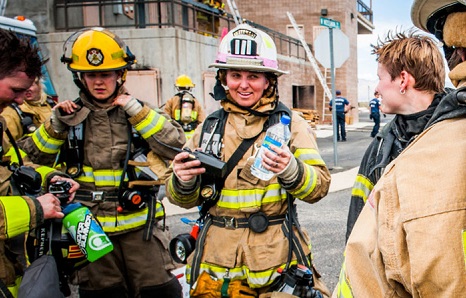By: Robert Avsec, Executive Fire Officer
I recently had one of those “I never thought of it that way,” moments about diversity and inclusion in an organization, particularly fire departments, because I did serve with the Chesterfield (Va.) Fire and EMS Department for 26 years before retiring as a battalion chief. See if any of what I’m about to share with you “strike’s a similar chord.”
THE ULTIMATE ORGANIZATION
For my money, it’s the human body. What an amazing amalgamation of diverse types of cells, organs, and systems that work in harmony 24/7/365, all working in concert under the direction of a master conductor, the brain.
I have never had to take Worker’s comp or sick leave for any injuries during my fire service career. But recently, I developed tendonitis in my left wrist, my “non-dominant hand.” Which prompted me to think why aren’t all humans ambidextrous? Because nothing in my mind shows how ridiculous the term “non-dominant hand” truly is until it’s injured! For the rest of this piece, I’m going to—for the sake of brevity—use the term hand to refer to the shoulder, arm, wrist, and hand when speaking of “dominant hand” and “non dominant hand.”
WHEN A HAND IS INJURED
When either hand is injured, and unable to fully do its job, what do we do? Well, if you’re like most people first, you first deny that it’s that bad! But if it’s bad enough, we eventually seek medical attention, which in many cases involves:
- X-rays or other imaging technology to aid the physician in their diagnosis
- The physician prescribing a course of treatment (e.g., rest, medications, physical therapy).
- Follow up appointments with the physician to evaluate how well the injury is responding to the course of treatment.
HOW DOES THIS RELATE TO DIVERSITY AND INCLUSION?
Like the human body, organizations have many components. They must work together in harmony if the organization is to be successful in achieving its goals.
What if, in the human body, the “dominant hand” did not work in harmony with the “non-dominant hand?” What if, when the “non-dominant hand” was injured, the brain didn’t acknowledge that and direct the “dominant hand” to “pick up the slack” until the injured “non-dominant” hand was 100-percent? What if the brain and the “dominant hand” refused to let the “non-dominant hand” resume 100-percent of its functions and responsibilities once it was completely healed?
Now, let’s substitute fire chief (for the brain), dominant group (for the dominant hand) and non-dominant group (for the non-dominant hand) and see if you make the same connection between the human body and organizations as I did when it comes to dominant groups and non-dominant groups and diversity and inclusion in an organization.
PROGRAM NOTE: The terms dominant group and non-dominant group refer to numbers in an organization. In most fire departments, the dominant group consists of white males based on sheer numbers, and because they comprise the dominant group, they’ve developed the organization’s rules and cultural elements.
Read Next: Is Your Dominant Group Bias Showing?
The connection I made is that organizations must work towards the goal of being “ambidextrous.” Now, more than ever before, organizations need both the dominant group and the non-dominant groups to work in harmony. And that means developing an organizational focus on getting members of the non-dominant group, whatever they need to become an “equal hand.”
HOW TO DO THAT?
The first rule of getting out of a hole is to quit digging. For many fire departments, that means quit marginalizing the need to have fully productive members of the non-dominant group who are fully engaged in all aspects of fire department functions.
The first women entered the fire service in the US in the mid-1970s. So, why in 2021 do women make up only 4-percent of career firefighters almost four decades later? I submit that it’s not because women don’t know about opportunities or don’t take advantage of opportunities.
Rather, it’s because we still have too many fire departments where women, and other members of the non-dominant group, are not valued and appreciated as the necessary “other hand.”
For starters, just Google the term “sexual harassment and female firefighters” and see what “pops up.” (I’m flabbergasted—and somewhat ashamed—at what keeps appearing when I do that when doing my research for articles like this one).
And I found that there is an even bigger problem on social media platforms. I belong to several Facebook groups where the target membership is women in the fire service, and I actively follow several others. And what I see consistently are female firefighters writing about their working environment, and how it’s making it difficult to continue in the job. My take is that covert harassment is even more prevalent for many members of the non-dominant group then the more publicized overt harassment.
So, my initial advice to any fire department leadership would be to get an accurate “temperature of the room.” Engage the members of the non-dominant group in focused conversation groups to learn what it’s really like to be a member of the non-dominant group in your fire department.
Then have a similar focused conversation with a sizable number of members from the dominant group to learn what they think about the non-dominant groups in your fire department.
If you can do that in an open and honest manner with both groups, I believe you’ll have identified the “gap” that exists in expectations between the two groups. And it’s that “gap” that you must close if you are to have a truly “ambidextrous fire department.”
If you were reading this piece expecting to see a list of to do items to achieve that goal, I’m sorry to have disappointed you. But, as my fire service colleague, author, and attorney, Chief Curt Verone, says frequently “this isn’t a problem that can be solved with transactional solutions” (e.g., policies, SOGs, and training). Rather, it requires transformational solutions, and transformational solutions involve getting to know your people. What are their expectations, their hopes, their fears, and their desire to be part of any solution?
If you can be successful at that, then I believe you’ll have a much better understanding of what needs to change in your fire department. And don’t be surprised when you learn that much of what needs to change are behaviors on the part of members of the dominant group.
 Fire & EMS Leader Pro The job of old firefighters is to teach young firefighters how to become old firefighters!
Fire & EMS Leader Pro The job of old firefighters is to teach young firefighters how to become old firefighters!



